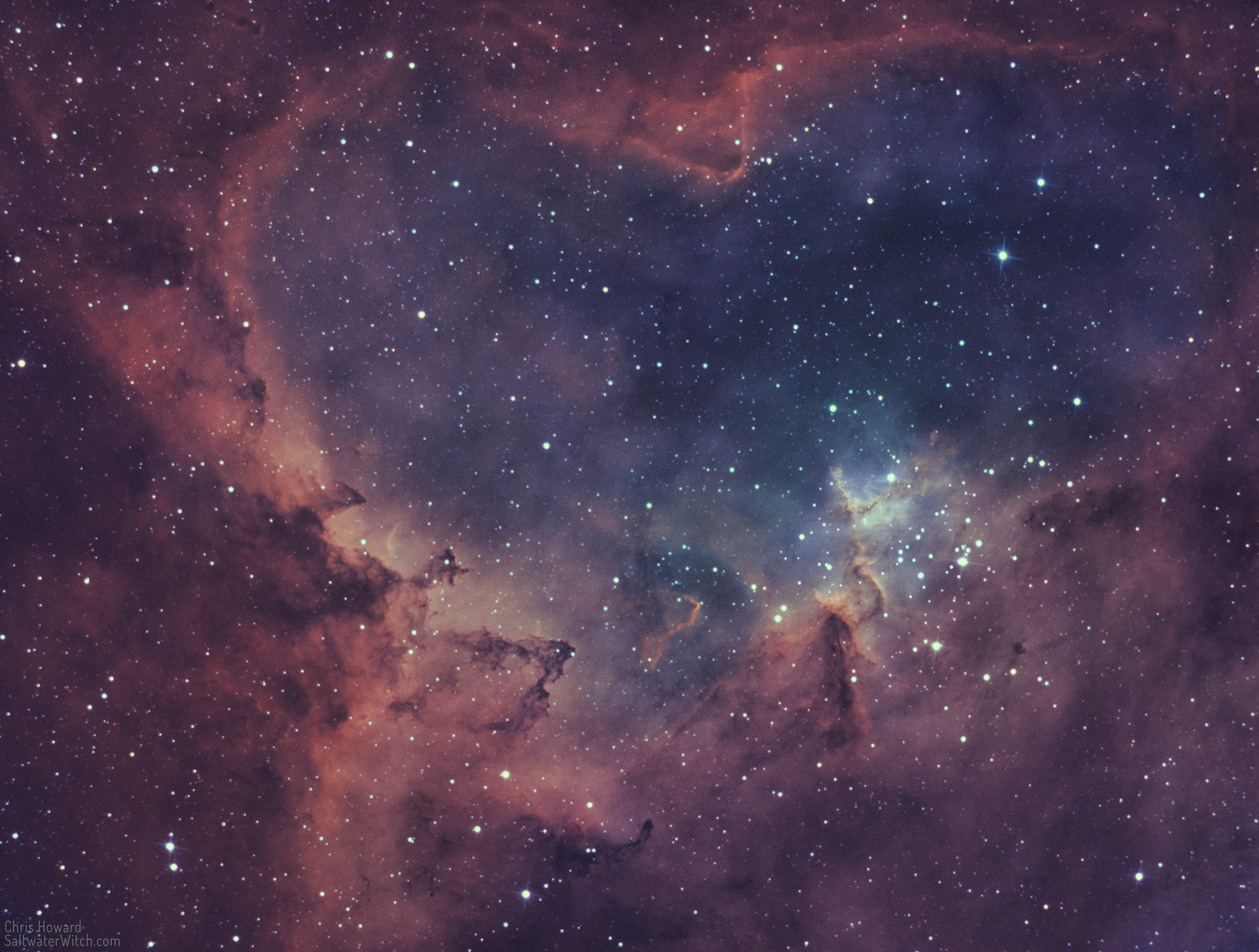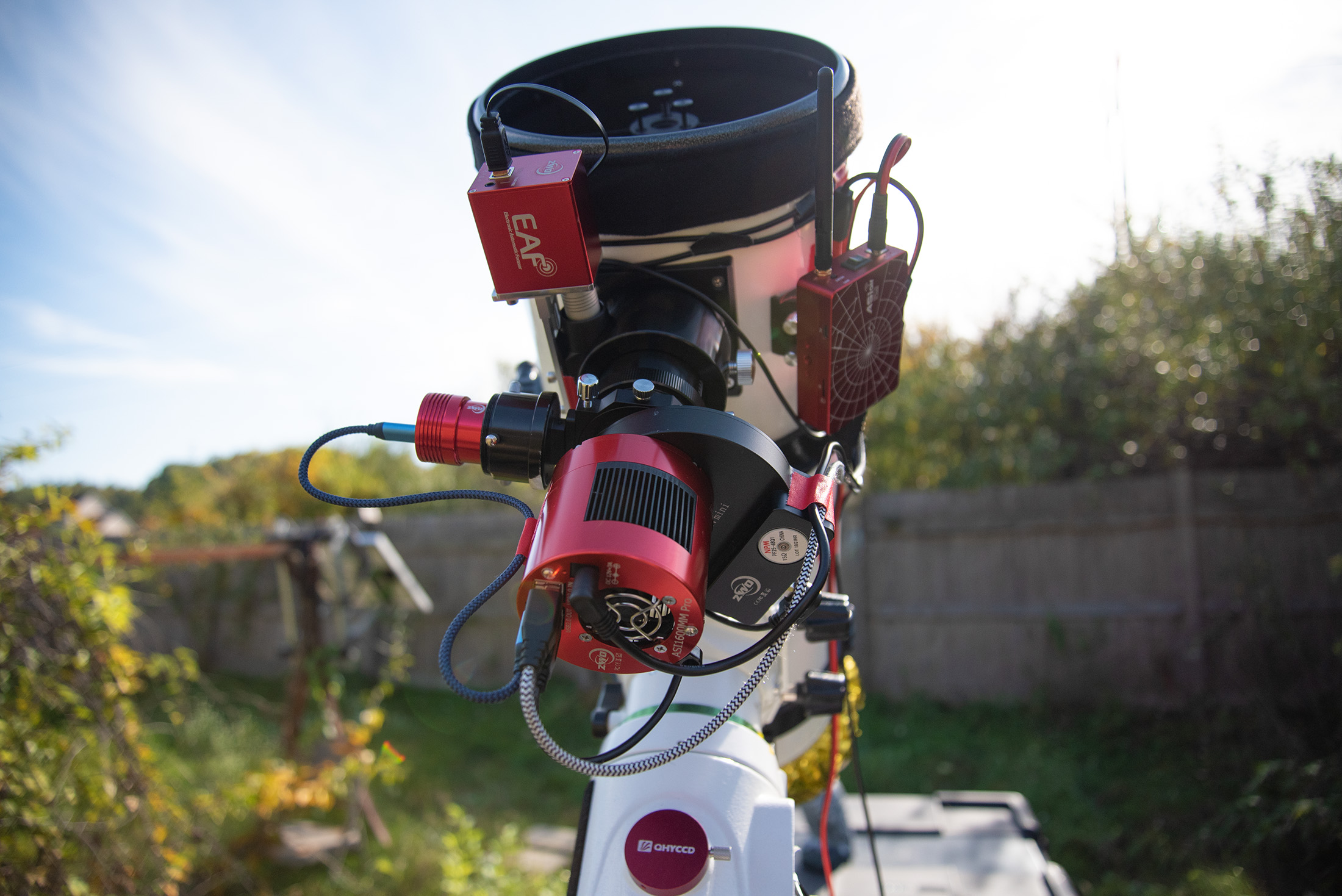A few more from this run of clear October skies
A few more processed (to some degree) images from the data I have gathered over the last five clear nights. Gear notes: I captured all the data for these in my backyard with an Apertura 800mm f/4 Newtonian OTA, ZWO ASI1600MM-Pro mono camera, Antlia 3nm filters, ZWO ASI290M OAG, on the Sky-Watcher EQ6R-Pro mount with the ZWO ASIAir Plus controller.
The core of the Heart Nebula (IC 1805) in Ha+OIII with the star cluster, Melotte 15 surrounding coils and branches of interstellar dust and gas.

Here's the Tulip Nebula (Sharpless 101) in Ha + OIII, a very energetic HII region about 6000 lightyears away in the constellation Cygnus.

The Jellyfish Nebula (IC 443, Sharpless 248) in hydrogen-alpha. IC 443 is a (Sh2-248)) is a supernova remnant about 5000 lightyears away in the constellation Gemini. Trailing off, out of frame top left, is the HII region Sharpless 249. There's ongoing research to determine if these two interact, but they probably do not. SH2-249 is most likely further away than the IC 443 supernova remnant. [https://ui.adsabs.harvard.edu/abs/1984A%26A...140..395D]

Posted October 23, 2022
M42 up close in Ha
The Orion, De Mairin and Running Man Nebulas (M42, M43, NGC 1977) in narrowband hydrogen-alpha. 36 x 300-second exposures, Newtonian 800mm @ f/4.

Posted October 22, 2022
The Rosette in Ha
The Rosette Nebula (Sh2-275, Caldwell 49) is an HII region and star forming complex in the constellation Monoceros, about 5,200 lightyears away and about 130 lightyears across. The dark chain of interstellar gasses and dust along the bottom is punctuated with Bok Globules, dense regions of star formation. The open cluster of massive blue stars in the center (NGC 2244) are responsible for ionizing the surrounding hydrogen, oxygen, and other gasses; bathed in the intense radiation from these stars, the clouds themselves emit light. These giant stars originally formed out of the nebula and they're now in the process of hollowing out the cloud structure and creating the bubbles of ionization visible around the nebula's core.

Posted October 21, 2022
The Elephant's Trunk in Ha
IC1396A, the Elephant's Trunk Nebula, is a twisted towering structure of interstellar gas and dust, back-lit and ionized by the intense radiation of the massive star just above it (HD 206267, HR 8281). The nebula's mix of organic and geometric shapes rimmed in light makes it stand out amid the eerie streams and swirls of dark nebulae and the backdrop clouds of ionized hydrogen that make up the expansive IC1396 HII region in the constellation Cepheus. The Elephant's Trunk is about 2,400 lightyears away and towers about 25 lightyears, or almost 150 trillion miles top to bottom (236 trillion kilometers). Imaging notes: 30 x 300-second subs in Ha, stacked in DSS. Apertura 800mm f/4 Newtonian OTA, ZWO ASI1600MM-Pro mono camera, Antlia 3nm Ha filter, ZWO ASI290M OAG, on the Sky-Watcher EQ6R-Pro mount with the ZWO ASIAir Plus controller.

Posted October 20, 2022
Narrowband with the Newt
We finally had some clear-ish skies last night after several days of gloom and rain, and I got to test out the 800mm f/4 newtonian scope with the ZWO ASI1600MM-Pro monochrome camera and 3nm narrowband filters. I spent most of the night imaging NGC 6888, the Crescent Nebula in Ha and OIII, and around 2am moved to the other side of the sky (away from a ~30% waning moon) to capture the Horsehead Nebula (B33) and the Flame Nebula (NGC 2024, Sh2-277), along with the leftmost star in Orion's Belt, Alnitak (bright star with the diffraction spikes from the Newtonian's secondary mirror) Alnitak is actually a triple star system, with most of the light and energy coming from ζ Orionis (zeta Ori), a massive blue super-giant 20 times larger than our star and over 21,000 times brighter. Imaging notes: 20 x 300-second subs in Ha, stacked in DSS. Apertura 800mm f/4 Newtonian OTA, ZWO ASI1600MM-Pro mono camera, Antlia 3nm Ha filter, ZWO ASI290M OAG, on the Sky-Watcher EQ6R-Pro mount with the ZWO ASIAir Plus controller.

NGC 6888, the Crescent Nebula in Ha+OIII. The Crescent is an emission nebula 25 lightyears across, about 5000 lightyears away in the constellation Cygnus. This interesting set of structures with multiple shock waves, including an inner shell of hydrogen surrounded by an expanding envelope of oxygen (the semi-transparent bubbling blue structure) is the result of a collision of the fast-burning Wolf-Rayet star WR136 with a massive red-giant star. I usually shoot the Crescent in hydrogen-alpha only, and that will only pick up that inner crusty blob, but it's way creepier with the oxygen bandpass data and that weird semi-transparent blue sleeve, perfect for October. Imaging notes: 80 x 300-second subs in Ha and OIII, stacked in DSS. Apertura 800mm f/4 Newtonian OTA, ZWO ASI1600MM-Pro mono camera, Antlia 3nm Ha, OIII filters, ZWO ASI290M OAG, on the Sky-Watcher EQ6R-Pro mount with the ZWO ASIAir Plus controller.

Posted October 19, 2022
ASIAir Plus with the Sky-Watcher
Trying something new tonight. So far, I've only used the ZWO ASIAir Plus with the AM5 mount and my William Optics scopes. So, I'm setting up the Sky-Watcher EQ6R-Pro and the 800mm Newtonian for narrowband, and decided to try out the ASIAir with this combination of gear. It has every feature I use with NINA (my normal astro controller system), that's polar alignment, plate solving, sequenced capture, guiding, so should work well!

Posted October 16, 2022
Orion Nebula in RGB
It's that time of year—my favorite, in fact. The autumnal equinox was on the 22nd, and that means Orion is back in the night sky, well actually in the very early morning sky. Last night the whole constellation was above the trees, around 25° rising in the East at 2 AM, and I captured 30 subs each for Red, Green, Blue, Luminance. Here they are stacked and processed.
Posted September 29, 2022
The Ghost of Cassiopeia
Gamma Cassiopeiae (γ Cassiopeiae) or just "Gamma Cas" and sometimes "Navi" is the center star in the "W" asterism that makes up the constellation Cassiopeia, one of the easiest constellations to find in northern hemisphere skies. It's an eruptive variable star—which sounds exciting for a star; this basically means it is unpredictably variable, with an apparent magnitude between 1.6 and 3, and does not follow an observed repeatable cycle. The two nebulae IC63 ("Ghost Nebula", below γ Cass in this rotation) and IC59 (above) are fairly dim, but do reflect light from γ Cass and other nearby stars, and IC63 exhibits some emission properties, gaining energy and then emitting it as light. Gamma Cas and both nebulae are about 550 lightyears away, very close to us. In terms of distance from Earth, this is one of the closest Deep Sky Objects I have ever captured, and M45, the Pleiades, at around 450 lightyears may actually be the closest. Imaging Notes: 93 x 180-second subs across Red, Green, Blue filters (Astronomik Deep Sky RGB), ZWO ASI1600MM-Pro monochrome camera running at -10C, ZWO AM5 EQ mount, William Optics SpaceCat 51 apochromatic refractor, ZWO ASI290MM guide camera with OAG.


